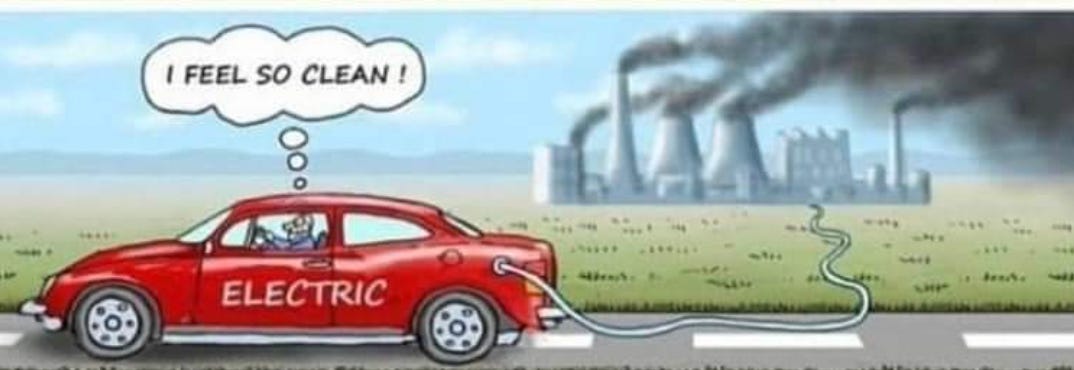Nova Scotia's Clean Cars Have A Dirty Little Secret
What do we have to do to give every Nova Scotian a reason to believe that plugging in their car isn’t just a gesture—but a genuine leap toward a cleaner, smarter, more sovereign energy future.
THE STING: The Category Error of Electric Cars
Here in Nova Scotia, we don’t drive electric cars. We drive battery-powered cars. It’s not a semantic difference. It’s a category error.
Calling them “electric” makes it sound like the energy comes from some ethereal, immaterial source — clean, silent, and pure. A battery-powered car is awesome, powerful and quiet, but it’s only as clean as the grid that charges it.
And in Nova Scotia, about half of our plug-in power still comes from fossil fuels, mostly coal. The rest is split between local renewables and imported hydro. Not fairy dust. Not sea breezes. Not the moral superiority of climate conferences. Coal.
So, for now, swapping your gas tank for a battery and plugging it in isn’t necessarily a revolution. It’s just trading one fossil fuel for another, with a longer extension cord.
Until we clean the grid, calling these cars “green” is just branding.
And Those Batteries?
The problem isn’t just where the power comes from — it’s what’s holding it.
Making lithium-ion batteries means tearing open the earth for lithium, cobalt, and rare earth metals, often in places where environmental oversight is a punchline and child labour is part of the business model. The mining is energy-intensive, water-intensive, and often done in fragile ecosystems or poor communities that never get a say.
In Nova Scotia today we’re having a pretty big discussion as the government puts all the options on the table for mining and resources extraction. But the people who are a box of birds about lithium exploration here have little to say about importing ever more and bigger cars and batteries that are its end use.
Batteries degrade over time, meaning your $60,000 virtue signal may need a new $20,000 battery pack before you feel like you got your money’s worth. That’s assuming it doesn’t catch fire first or just freeze up in the cold.
And disposing of them? There’s no smooth, circular economy here. Large-scale battery recycling is still in its infancy, and most old batteries are either stockpiled, shipped (back) offshore, or landfilled.
We didn’t solve the pollution problem. We just moved it to another continent.
This probably sounds meaner than it’s intended.
The point is just this:
Large complex systems generate unintended consequences.
Hand-slapped ‘we got that fixed’ solutions that really only mask symptoms or move the problem to a place we can’t see it is a cataogroy that we shouldn’t beat ourselves up over to the point of becoming self-hating, but nor should we be complacent and let it release our conscience from our greater purpose. We need to keep our place on the front line of struggling people doing their best to imagine what a BETTER future really means and looks like.
It’s Easy To See a Better Way Ahead —There’s Good Times Coming
Like all things electric, studies show EV’s are getting WAY better all the time.
So, instead of saying ‘problem solved’, let’s just set a serious goal to get off the dope of coal, and disposability, and the other things that are holding us back.
Even charged on a coal-heavy grid like Nova Scotia’s, electric cars emit significantly less over their lifetimes than gasoline vehicles—typically breaking even within the first year of driving, after which their superior efficiency means almost no additional emissions. That’s because EVs can convert energy into motion about three times more efficiently than internal combustion engines. Once an EV’s initial manufacturing carbon debt is paid off, each mile driven adds only a fraction of the emissions compared to gas cars. We just gotta make them last. And as Nova Scotia’s electricity mix becomes cleaner—shifting from coal to renewables—that emissions gap widens further. In short: even on a dirty grid, driving electric is cleaner today and getting even cleaner tomorrow.
If Nova Scotia wants to make good on the promise of cleaner transportation, the next step is obvious: changing our actual power sources, some of the rules, and our… I’m going to say tastes, though I don’t think that describes it well… for the big SUV’s and pickup trucks we seem to be obsessed with. It’s not just about plugging in more EVs—it’s about cleaning up what they plug into. That means retiring coal. Building more wind, more solar, more storage. Supporting smart grids and second-life battery uses. And giving every Nova Scotian who wants to help the future a reason to believe that plugging in their car isn’t just a gesture—but a genuine leap toward a cleaner, smarter, more sovereign energy future.
Until then, our clean cars will run on dirty secrets.
One More Thing: Size Matters
Maybe the smallest thing Nova Scotia could do is the best thing. Our vehicles just don't need to be as big and heavy as they are. Some mix of machoism, redneck oneupmanship, and fear is leading us into vehicles that are much bigger, more complicated, and less user servicable than we need them to be. China is proving that there are thousands of different vehicles that can be made efficiently and inexpensively for every purpose we can imagine.
Gotta haul some lobster? There are WAY better solutions for that than the highest RAM or F number your bank will let you trade your kids’ future for.
Gotta move your tools and gear? That sprinter is way overkill.
Gotta zip across the peninsula to get the kids to gymnastics? Believe it or not, there are infinite spaces between that Lincoln Navigator and that Dutch cargo bike that are a lot better suited to the purpose.
It’s just that you’ve never seen them because they are illegal to import to Nova Scotia.
But they exist. We could import them. Or even way better, we could make them ourselves, and make them repairable such that the owners good own them for a generation, not just a couple model years.
It’s a smarter path forward—fewer materials, smaller batteries, and far lower emissions than the heavy, macho vehicles dominating our roads, but also fit for our climate, roads, geography, and purpose. We don’t need giant machines; we need sensible, sustainable transport. These compact gems could be the key to halving our transport emissions simply by encouraging lighter, smarter choices.
Let’s not just chase electrification—let’s rethink scale and what we really want from vehicles as households and as part of a country that wants to be awesome.
Maybe the best way to get half the vehicles in Nova Scotia off the road by the end of the century is just to keep the same number of vehicles and make them half as big and heavy.
Maybe the best way to make things last is to make things that last.
And maybe the best way to make people care for and keep vehicles is just to offer beautiful, easily serviceable vehicles that people care for and keep because they love them.












Not sure where you get your info from on the vehicles but batteries are based on "cycles" this is once again to believe everyone drives electric because of the environment , yes they are called electric powered vehicles. Batteries don't move the vehicle electric motors do. I drive electric because they are fast, powerful, cheap to own and operate and defiantly WAY more efficient than gas powered vehicles. 1 gallon of gas is equivalent to 33KwH of energy and most gas vehicles hold 17 gallons of gas! That means the gas vehicle has over 561KwH of energy but can only travel around 400-500km full. As a comparable EV has 80KwH of energy and can go the same distance. Now lets talk environment with gas, what happens to the 70+% of wasted fuel from the gas powered vehicle? goes into the environment. As well gas is pumped from the ground with electricity has to be refined and transported as well it expires. Yes i charge my cars with solar!
Not sure where you get your info from on the vehicles but batteries are based on "cycles" this is once again to believe everyone drives electric because of the environment , yes they are called electric powered vehicles. Batteries don't move the vehicle electric motors do. I drive electric because they are fast, powerful, cheap to own and operate and defiantly WAY more efficient than gas powered vehicles. 1 gallon of gas is equivalent to 33KwH of energy and most gas vehicles hold 17 gallons of gas! That means the gas vehicle has over 561KwH of energy but can only travel around 400-500km full. As a comparable EV has 80KwH of energy and can go the same distance. Now lets talk environment with gas, what happens to the 70+% of wasted fuel from the gas powered vehicle? goes into the environment. As well gas is pumped from the ground with electricity has to be refined and transported as well it expires. Yes i charge my cars with solar!